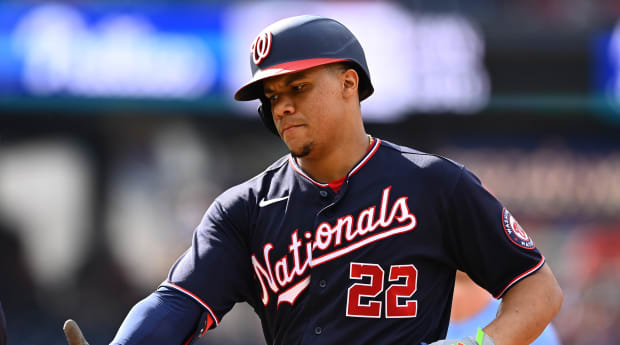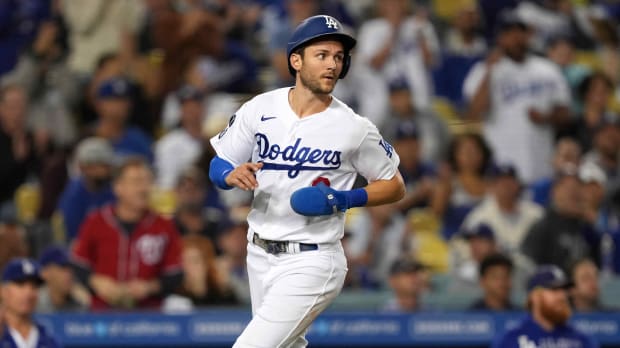View the original article to see embedded media.
The Nationals have two options now that Juan Soto reportedly has turned down their 15-year, $440 million extension offer: trade him before the Aug. 2 deadline and replenish the farm system with what should be an unprecedented return of prospects, or make the most of their remaining time with him.
The first choice is tantalizing for baseball fans. Imagine Soto, the greatest young hitter since Ted Williams, spending the next three pennant races in a Dodgers outfield with Mookie Betts and Cody Bellinger and reuniting with his good buddy Trea Turner. Dream of his sweet, left-handed stroke sandwiched between Aaron Judge and Giancarlo Stanton, launching dinger after dinger into the Yankee Stadium seats. Think of Uncle Stevie Cohen ordering his front office to make Soto a Met, financial and prospect costs be damned. Consider the sorcery of Jerry Dipoto pulling off his craziest trick yet and putting Soto in the lineup with Julio Rodríguez as the Mariners finally end their two-decade playoff drought.
But for as much fun as it is to ponder these possibilities, the more logical choice here is the second one. No amount of blue chip prospects can equal the value of Soto.
VERDUCCI: Inside the Mind of MLB’s Best Hitter
So, instead, Washington should do whatever it possibly can to put a competitive team on the field for the two years left after this one before he hits free agency.
Sound unreasonable? Perhaps. The Nationals are the worst team in baseball right now, and reinforcements aren’t coming up through their depleted farm system. That also means they don’t have prospects to trade for competent big leaguers. Their tools are limited, but they do have one solid resource they can use to improve their roster for 2023 and ’24: money.
They can’t invest in him long term, so they should use some of the money they were going to use to extend Soto to assemble a contender around him while they still can.

Kyle Ross/USA TODAY Sports
According to The Athletic’s Ken Rosenthal, Washington was willing to pay Soto an average annual salary of $29.33 million, which would’ve started lower and gradually increased over the length of the contract, per the New York Post’s Jon Heyman. Soto is making $17.1 million this season, and he will certainly get more than that in each of the next two years of arbitration eligibility; what he ends up earning in 2023 and ’24 might not be all that much lower than the AAV of the extension. For the sake of this exercise, let’s say he gets $19 million next year—which is what Aaron Judge is making this season in the final year of his arbitration eligibility—and $23 million in ’24.
Right now, the only three Nationals with guaranteed salaries on the books for Nationals next season are Patrick Corbin ($24.4M), Stephen Strasburg ($35M) and Nelson Cruz, whose contract has a mutual option for 2023. If the option is picked up and he decides to stay in D.C., he’ll make $16 million. If he does not return, the Nats will owe him a $3 million buyout. Either way, they are looking at a luxury tax payroll of about $79 million before factoring in the salaries of arbitration eligible and pre-arbitration eligible players. Add in that $19 million for Soto and we’re at $98 million.
This year, they are paying roughly $17 million to the rest of their arbitration eligible players; let’s assume that figure next year is $20 million. Let’s say they have to pay all of their pre-arb guys a total of $13 million, up about $2 million from this season. All in all, that would put their luxury tax payroll at $131 million, or $102 million below the first luxury tax threshold.
What can they do with that $102 million? Well, for starters, they can re-sign first baseman Josh Bell for, say, three years and $36 million, or $12 million per year. That puts their luxury tax space at $90 million. Then, go big for an ace. Sign someone like Joe Musgrove, who turns 30 next year, to a six-year, $138 million deal ($23M AAV). That leaves them with $67 million to play with.
Even with Musgrove, they still need to improve their rotation, which this year is by far the worst in MLB. So, they sign All-Star lefthander Martín Pérez, one of this season’s surprising successes, for two years and $20 million, and veteran righthander Corey Kluber to a one-year, $10 million deal—which is $2 million more than he’s making this season with the Rays. Now they have $47 million to play with before reaching that first tax threshold. Let’s beef up their offense a bit more, shall we?
Shortstop Luis García, who turns 23 next season, is a bright young talent for Washington, but he’s a better long-term fit for second base. Good thing for the Nationals, then, that there are four great shortstops who could be available in free agency this offseason: Carlos Correa, who can opt out of the three-year, $105 million deal he signed with the Twins back in March; Atlanta’s Dansby Swanson, who is the best shortstop in baseball this year based on FanGraphs’ WAR (4.2); Boston’s Xander Bogaerts, who can opt out of the four years and $80 million remaining on his contract; and Turner, whom Washington traded to the Dodgers just before last year’s trade deadline.
Correa is almost certainly out of the question. He’ll only opt out of his deal if he thinks he can make more than the $35.1 million per year he’s getting with Minnesota. It feels like Swanson, who is 28 right now, will re-sign with Atlanta, but then again, that’s what we thought about Freddie Freeman. According to Spotrac, Swanson’s market value is six years at an average annual value of $22.1 million. The added benefit here for the Nationals would be weakening a division rival, too. Bogaerts, who will be 30 next year, has greatly improved his defense while maintaining his All-Star caliber production at the plate. It would be reasonable for a team to sign him for $25 million per year—which is what Marcus Semien is earning to play second base with the Rangers—because he has a better track record than Swanson.
Turner’s case is interesting. It feels unlikely that the Nationals would decide to give him close to $200 million after trading him last year because they thought they couldn’t afford to re-sign him. But that was when they were still trying to extend Soto. If they don’t think they have any shot at signing Soto after he becomes a free agent, they should consider giving less than half of what they offered Soto to Turner. Spotrac puts Turner’s market value at $32 million per year for six years. Give him more years for less AAV, maybe an eight-year, $240 million, or $30 million per year, and maybe that would get it done.
So, after signing a top-tier shortstop, either Swanson for $24 million per year (a little above market value, just for this exercise) or Turner for between $30–$32 million per year, the Nationals have $15–$23 million left before that first threshold. They can use that to improve their bullpen. Some of the soon-to-be free-agent relievers are Aroldis Chapman, Kenley Jansen, Craig Kimbrel, Edwin Díaz, Zack Britton (who hasn’t pitched this year while recovering from Tommy John surgery), Daniel Bard, Alex Colomé, Adam Ottavino and David Robertson. The Nationals can sign two from that group and still stay under the first tax threshold.

Kirby Lee/USA TODAY Sports
If they make these moves, their Opening Day roster would look something like this:
Rotation:
1. Joe Musgrove
2. Martín Pérez
3. Corey Kluber
4. Josiah Gray
5. Stephen Strasburg
6. Patrick Corbin
Relievers:
1. Aroldis Chapman or Craig Kimbrel
2. Daniel Bard, Alex Colomé, Adam Ottavino or David Robertson
3. Kyle Finnegan
4. Mason Thompson
5. Cade Cavalli
6. Cole Henry
Lineup:
1. Dansby Swanson or Trea Turner - SS
2. Juan Soto - RF
3. Josh Bell - 1B
4. Nelson Cruz - DH
5. Luis García - 2B
6. Keibert Ruiz - C
7. Yadiel Hernandez - LF
8. Carter Kieboom - 3B
9. Victor Robles - CF
Is this a playoff team? Maybe not, but it would at least be competitive. Also, with some more roster maneuvering, they could add another major-league bat or two to this lineup and stay under the first tax threshold. Then again, nothing says the Nationals couldn’t exceed that first threshold.
The bottom line is the Nationals have the modern day Ted Williams on their roster for two more seasons after this one. Unless they traded Soto for Shohei Ohtani they wouldn’t get an equitable return, and certainly no package of prospects short of a historic haul would be worthy of Soto.
Yes, Soto is going to test free agency, and the Nationals probably won’t be able to afford him in a bidding war with the Yankees, Dodgers, Mets or any of MLB’s other high rollers. But there is a way for them to get as much value as possible from him while he’s still on the team.
They just need to make an investment in the roster, and they’ve already set aside the money to do so.




!["[T]he First and Fifth Amendments Require ICE to Provide Information About the Whereabouts of a Detained Person"](https://images.inkl.com/s3/publisher/cover/212/reason-cover.png?w=600)


